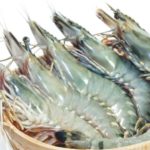In culinary culture, shrimp is a delicious cuisine that almost everyone loves. However, when enjoying food made with this ingredient, a question has long troubled many people: Should you remove the head and intestine of a shrimp before eating it?
When I took this question to an old fisherman, he shared his experience with us. Today, through this article, you can enhance your knowledge and gain experience in processing to make more delicious and enjoyable shrimp dishes.

First, we need to understand what is the intestine of a shrimp?
The intestine of a shrimp, or also known as a shrimp’s vein, is located at the back of a shrimp and is also its digestive tract. Due to the living environment and feeding habits of shrimp, undigested food residue and sediment can remain in the shrimp’s intestine. This is also the reason why many people still have doubts about the safety of a shrimp’s intestine when eaten.
So, should you remove the shrimp’s intestine?
The old fishermen told us that there is no definitive answer to this question, it depends on the specific situation.
On the one hand, in terms of hygiene, shrimp’s intestine should be removed when processed. Because the intestine of a shrimp can contain bacteria, parasites, and other microorganisms harmful to human health. Especially when shrimp are eaten raw or not cooked thoroughly, these microorganisms in the intestines of shrimp can have negative effects on the body. Therefore, if you eat raw or semi-cooked shrimp, remove the intestines and heads of the shrimp to ensure food safety. Or if you use shrimp to cook for children, it is best to remove the intestines and heads to ensure food hygiene since children’s digestive tracts are still weak.
On the other hand, in terms of taste, the effect of the intestines of shrimp on taste is insignificant. For cooked shrimp, the intestine is small, and the bacteria in the intestines of the shrimp have been killed when exposed to high temperatures and are no longer harmful to the human body. Some people prefer to taste the original flavor of shrimp and do not remove the intestines of the shrimp to enjoy the full flavor of the shrimp. This is also acceptable. However, the intestine of the shrimp also has no nutritional value, and if you are still worried about the sediment in the intestine of the shrimp, you should consider removing the intestine to make the dish cleaner and more enjoyable.

In addition, these veteran fishermen also remind us to pay attention to the freshness of shrimp when buying and preparing them.
Fresh shrimp usually have firm flesh and bright colors, while shrimp that have begun to spoil have soft and dull flesh. For fresh shrimp, the presence of intestines will not affect the taste. On the contrary, for shrimp that have begun to spoil, even if the intestine is removed, the smell and taste of the dish will significantly decrease.
Therefore, when buying and eating shrimp, we should choose fresh shrimp and process them properly before cooking.
So, how do you remove the shrimp’s intestine?
There are three methods you can use to remove a shrimp’s intestine.
Method 1: Using a toothpick
Use the pointed end of a toothpick to poke into the second segment of the shrimp’s back, and you can easily remove the intestine. This method is simple and can be done by anyone and is suitable when you cook at home.

Method 2: Using scissors
Use scissors to cut off the shrimp’s head. Then gently open the back of the shrimp and use your hand or tweezers to pull out the shrimp’s intestine. This method may seem a bit more complicated, but in general, it will help to keep the shrimp’s structure more intact. This method is suitable for restaurants and occasions when you prepare food for guests’ entertainment, where aesthetics are important.

Method 3: Peel the shell and then cut the back
After peeling the shell, place the shrimp on a cutting board and use a knife to cut a line from the shrimp’s head to its tail. Then, use the tip of the knife to easily remove the shrimp’s intestine. However, with this method, you will not be able to keep the shrimp’s structure intact.

Tips for choosing and preparing shrimp
First of all, when choosing shrimp, we should choose those with a complete shape, a bright color, and firm flesh. The back of the shrimp must be curved, if it is straight, the shrimp may be dead or spoiled. In addition, the shrimp must have clear, bright eyes and strong legs.
When cooking shrimp, you should try to choose simple cooking methods to keep the shrimp’s deliciousness and texture. Common cooking methods include steaming, boiling, stir-frying, roasting, etc. Cooking time must be controlled reasonably, avoid overcooking, as this will make the shrimp’s flesh soft and have a poor taste.

In summary, whether or not to remove the intestine when eating shrimp depends on personal preference and the specific situation. From a food safety perspective, the intestine should be removed when eating raw or undercooked shrimp. For cooked shrimp, the presence of the intestine does not significantly affect the taste or your health. Therefore, depending on your personal preferences or to ensure peace of mind while enjoying the dish, you can choose to remove the intestine or not. When choosing and preparing shrimp, we should pay attention to their freshness and the proper way to process them to ensure delicious and safe food.
According to Tổ Quốc
































